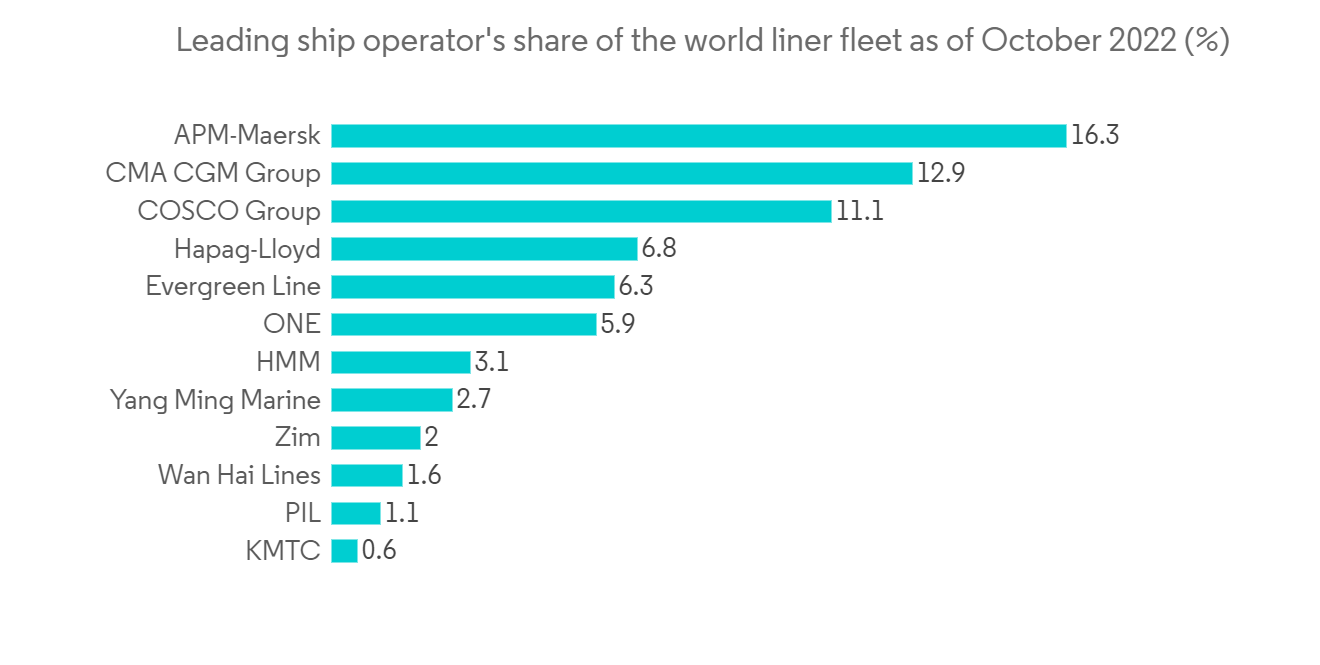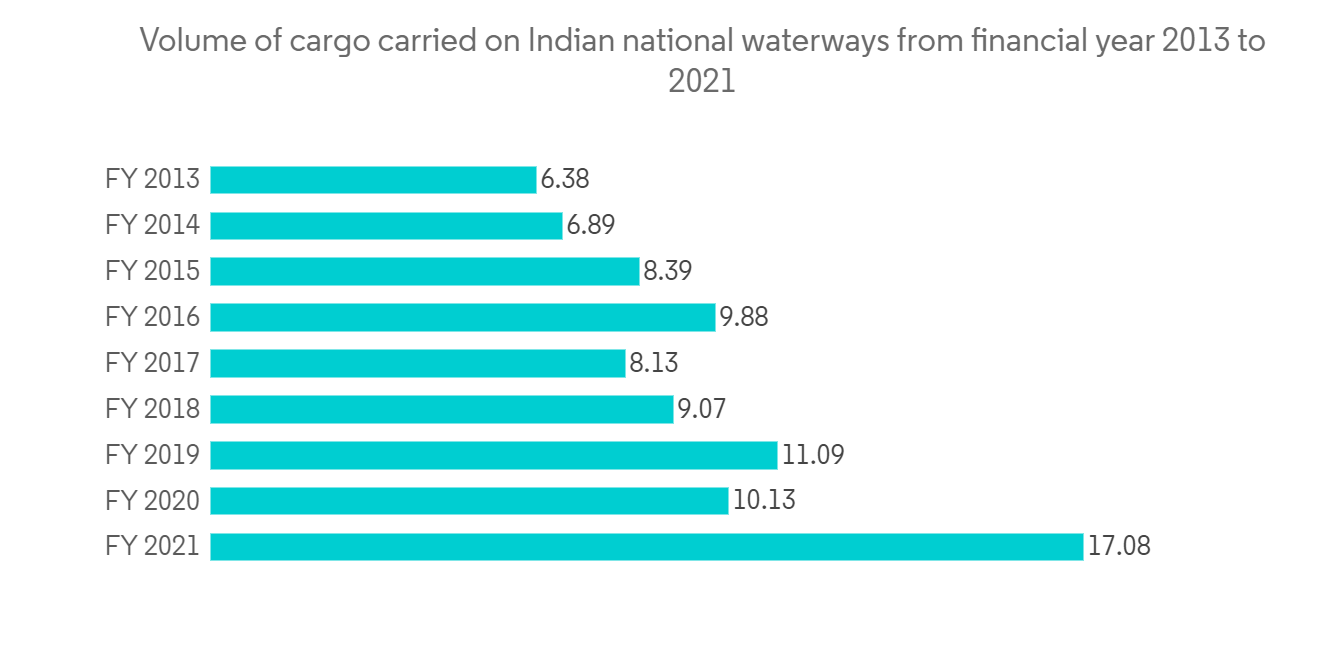 |
市場調査レポート
商品コード
1248152
内陸水運輸送市場- 成長、動向、予測(2023年-2028年)Inland Water Freight Transport Market - Growth, Trends, And Forecasts (2023 - 2028) |
||||||
● お客様のご希望に応じて、既存データの加工や未掲載情報(例:国別セグメント)の追加などの対応が可能です。 詳細はお問い合わせください。
| 内陸水運輸送市場- 成長、動向、予測(2023年-2028年) |
|
出版日: 2023年03月25日
発行: Mordor Intelligence
ページ情報: 英文 120 Pages
納期: 2~3営業日
|
- 全表示
- 概要
- 目次
内陸水運輸送の市場規模は今年度132億5,000万米ドル、予測期間中は3%以上のCAGRで推移すると予測されます。
主なハイライト
- 内陸水運輸送市場は、湖、川、沿岸内水路で貨物の内陸水運輸送を行う企業(組織、個人事業主、パートナーシップ)で構成されています。当事者間で交換される、または最終顧客に販売されるアイテムやサービスのみを対象とします。
- 内陸水運輸送の市場は、主に合理的な貨物輸送の必要性によって動いてきました。他の輸送手段と比較して運賃の価格設定に差があるため、水上輸送は一般的に重量物にとって手頃で経済的とみなされています。水上輸送の料金決定には、一般的なコンテナの立方メートルが頻繁に使用されます。一方、航空輸送の場合は、貨物の大きさと重さの両方を考慮して請求重量が決定されます。
- 内陸水運輸送の動向として、船舶管理のためのIT化が進んでいます。国連貿易開発会議(UNCTAD)によると、2019年、95402隻の船隊で、世界貿易の80%近くが水路で処理されています。船舶では、顧客関係管理、倉庫管理、キューイングシステム、燃料最適化、船舶性能の監視、スキャンコピーや画像からの文書認識などに情報技術が活用されています。船舶所有者が最適なバンカーポートを見つけるのを支援するオンラインリソースであるBunkerExや、センサーからのデータ、手動レポート、市場情報を使用して統一された船隊情報を作成するNautilus Labsは、船舶の運用管理に使用するオンラインツールやポータルの2つの顕著な例です。
- 内陸水運輸の市場は、原油価格の変動が水運業界に与える影響により、期中に阻害されると予想されます。国連貿易開発会議によると、世界の輸送に使用されるエネルギーの95%を供給する燃料油は、世界経済の重要な動力源となっています。燃料価格の上昇は製品のインフレを招き、製品輸送のあらゆる面に影響を及ぼします。燃料価格が下がれば、消費者はより安く商品を購入することができ、物流会社は節約した資金を業務強化に活用することができます。燃料価格の変動は、オペレーションコストに直接影響します。
- COVID-19の流行は海上輸送に影響を与えたが、その影響は当初予想されたほど深刻ではありません。2020年の海上貿易は、上半期のショックにより3.8%減少しました。しかし、下半期には非対称ながら一応の回復が見られ、第3四半期にはコンテナ貿易、ドライバルク商品ともに数量が回復しています。
内陸水運輸送の市場動向
より良い船舶管理のために、AIとデータ分析プラットフォームの利用が増える
内陸水運輸送事業では、船舶管理のための情報技術基盤の整備が進んでいます。クラウドベースのサービスを利用することで、情報へのリモートアクセスを可能にし、船員管理、通信、船上サービスリクエストなど、すべての船舶オペレーションをオフィスから管理・編成するためのソフトウェアソリューションが開発されています。
また、船舶監視ソリューションのシームレスな活用により、船舶の動静を把握し、乗組員が船内データを本社と共有して分析することで、意思決定プロセスの簡素化と業務効率の向上を図っています。
GHG排出量と燃料費の削減を目的に、海運企業はエネルギー効率の高い統合システムを採用することをますます目指しています。そのためには、スクラバーや舵から潤滑油、塗料、推進装置まで、船上のさまざまなシステムをアップグレードする必要があります。また、船舶や排気の設計を改善する事業者もあれば、廃熱回収技術を提供する事業者もあります。これらの追加技術の助けを借りて、海事事業は、燃料やエネルギーに費やす費用を抑えながら、事業の持続可能性を劇的に高めることができるかもしれません。
人工知能は、航路の最適化、自律航行、予知保全など、さまざまな目的で海事産業で活用されています。これらのプロセスにおけるAIの重要な目的は、センサー、公共情報システム、資産追跡によって得られる膨大な量のデータを消化し、実用に耐えうる洞察を得ることです。スタートアップ企業は、分析されたデータを使って、予測精度を高め、運転、保守、燃料のコストを削減することができます。また、水中ロボットや車両にAIを搭載することで、捜索・救助活動や水中での修理が容易になります。スタートアップ企業も、AIを活用して運航を継続的に監視し、船舶や港湾の管理を強化する船団、港湾、船舶のデジタルツインを提供しています。
競争力を維持するために、現在、多くの大手海運事業者は、プロセスの自動化、特定の職務のロボット化、データのデジタル化、クラウドやIoTの活用などを進めています。そのため、自律航法は、輸送可能な貨物量の増加、環境汚染の低減、運航コストの削減、運航時間の短縮などのメリットを提供し、貨物輸送業者を含む顧客に対する輸送回数やサービスの向上を可能にするため、遠からず関心を持つようになるでしょう。

アジア太平洋は内陸水運輸送の最速成長市場である
内陸運河輸送を、渋滞や容量問題に悩まされることの多い陸上輸送と比較すると、内陸運河輸送が最もクリーンで安全、かつエネルギー効率の高い輸送手段であることが一般的に認められています。内陸水運は、道路交通に代わるモーダルシフトとして推奨され、大型貨物車の交通事故件数を減らすことができます。例えば、インドでは全車両のうちトラックは5%に過ぎないが、交通事故原因の26%はトラックです。また、内陸水運は、河川を共有する複数の国の間で共有する輸送ルートを確立することで、地域の協力や統合を促進する可能性があります。欧州では、ドナウ川やライン川などの河川を利用して、大陸内の交易を促進してきたことがその例です。
インドでは、東南アジアの河川をタイまでつなぎ、地域の河川を相互に結びつけ、貿易を促進させるという構想があります。荷主、物流業者、貨物所有者は、8カ国を通過する5,000kmを超える国際水路網の計画から恩恵を受けるはずです。このネットワークを通じて、500億米ドル以上の貿易が可能になると考えられています。ミャンマーのシットウェ港は、インドがすでに建設しています。現在、航行可能な状態になっています。シットウェとミゾラムは川でつながっているので、ミゾラムとトリプラの双方にとって、国際貿易を促進するこの開発は有利になります。内陸水路と内航海運がつながれば、ミャンマー、シンガポール、タイなどとの新たな経済ルートが生まれ、地域全体にさまざまな波及効果をもたらすことが期待されています。

内陸水運輸送市場の競合他社分析
American Commercial Barge Line、Ingram Barge、Kirby Inland Marine、American River Transportation、CMA CGM Group、McKeil Marine Limited、AP Moller-Maersk A/S、Rhenus Group、 Imperial Logistics Internationalが重要な市場参入企業です。内水面輸送はグリーンカーゴの次を担うものであり、内水面輸送の発展は水路や運河の保護・保全に貢献することになります。原材料の輸送は、内水面輸送の重要な市場です。水路で供給されるプラントの生産量と輸送量は繋がっています。水路の信頼性が高く、施設の近くにアクセスがあれば、鉄道よりも内水面輸送の方がお得な場合もあります。このように、コスト効率や輸送ルートの実現性を考慮すると、市場は拡大傾向にあります。
2022年6月、B20クラブはアメリカン・リバー・トランスポーテーション社(ARTCO)を新たなメンバーとして加えました。ARTCOは、Archer Daniels Midland Co.の完全子会社で、ラインホール船、ハーバーボート、カバードホッパーバージ、タンクバージ、ハーバーおよびフリーティングサービス、フルサービスの造船所を運営しています。これらの事業により、ARTCOは製品を安全かつ効率的に最終目的地に届けることができます。また、ARTCOはミシシッピ川下流域と上流域、イリノイ川とオハイオ川で第三者による曳航サービスも提供しています。
その他の特典です:
- エクセル形式の市場予測(ME)シート
- 3ヶ月のアナリストサポート
目次
第1章 イントロダクション
- 市場の定義と範囲
- 調査の前提条件条件
第2章 調査手法
第3章 エグゼクティブサマリー
第4章 市場力学と洞察
- 現在のマーケットシナリオ
- 市場力学
- ドライバ
- 抑制要因
- 機会
- 産業の魅力- ポーターのファイブフォース分析
- 新規参入業者の脅威
- 買い手/消費者の交渉力
- 供給企業の交渉力
- 代替品の脅威
- 競争企業間の敵対関係の強さ
- バリューチェーン/サプライチェーン分析
- 技術的な進歩
- 政府規制と主な取り組み
- トランシップトレードの洞察
- コンテナ輸送と非コンテナ輸送の洞察
- 運賃と海上輸送コスト
- インターモーダル/コンテナ利用への洞察
- 需要-供給分析
- COVID-19の市場への影響について
第5章 市場セグメンテーション
- 交通機関の種類
- リキッドバルク輸送
- ドライバルク輸送
- 船舶の種類
- 貨物船
- コンテナ船
- タンカー
- その他の船舶タイプ
- 地域
- 北米
- 米国
- カナダ
- 欧州
- ドイツ
- オランダ
- ルーマニア
- ベルギー
- フランス
- その他欧州
- アジア太平洋地域
- インド
- 中国
- 日本
- オーストラリア
- その他アジア太平洋地域
- ラテンアメリカ
- ブラジル
- アルゼンチン
- その他ラテンアメリカ地域
- 中東・アフリカ地域
- UAE
- サウジアラビア
- その他中東・アフリカ地域
- 北米
第6章 競合情勢
- 市場集中の概要
- 企業プロファイル
- American Commercial Barge Line
- Ingram Barge
- Kirby Inland Marine
- American River Transportation
- CMA CGM Group
- McKeil Marine Limited
- AP Moller-Maersk A/S
- Rhenus Group
- Imperial Logistics International
- Safewater Lines*
第7章 内陸水運輸送市場の将来
第8章 付録
The size of Inland Water Freight Transport market is USD 13.25 billion in the current year and is anticipated to register a CAGR of over 3% during the forecast period
Key Highlights
- The inland water freight transportation market comprises companies (organizations, sole proprietors, and partnerships) that offer inland water freight transportation of cargo on lakes, rivers, or Intracoastal waterways. Only items and services that are exchanged between parties or sold to final customers are covered.
- The market for inland water freight transport has been primarily driven by the need for reasonable cargo transportation. Because of the discrepancy in fare pricing compared to other means of shipping, water freight is typically regarded as affordable and economical for heavy items. The cubic meter of the typical container is frequently used to determine the rate of water transportation. In contrast, the charged weight for air transportation is determined by taking into account both the size and weight of the cargo.
- An growing trend in the inland water freight transport business is the creation of information technology platforms for better vessel management. According to the United Nations Conference on Trade and Development (UNCTAD), in 2019, with a fleet of 95402 ships, nearly 80% of world trade was handled via waterways. Information technology is utilized on ships for customer relationship management, warehouse management, queuing systems, fuel optimization, monitoring vessel performance, and document recognition from scanned copies and images. BunkerEx, an online resource that assists ship owners in locating the best bunker ports, and Nautilus Labs, which uses data from sensors, manual reports, and market information to create a unified fleet intelligence, are two notable examples of online tools and portals used for operations management on ships.
- The market for inland water freight transport is anticipated to be hampered during the term due to the impact that crude oil price volatility is having on the water transportation industry. Fuel oil, which provides 95% of the energy used in worldwide transportation, is a significant source of powering the global economy, according to the United Nations Conference on Trade and Development. Increased fuel prices lead to product inflation and have an impact on all facets of product transportation. When fuel prices decline, consumers can purchase items for less, and logistics companies can utilize the money they save to enhance their operations. Operational costs are directly affected by variations in fuel prices.
- Although the COVID-19 epidemic affected marine travel, the effects were not as severe as first anticipated. Maritime trade decreased by 3.8% in 2020 as a result of the shock in the first half of the year. However, there was a tentative, though asymmetrical, recovery in the second half of the year, and by the third quarter, volumes had restored for both containerized trade and dry bulk commodities.
Inland Water Freight Transport Market Trends
Increasing use of AI and Data analytics platform for better vessel management
A growing trend in the inland water freight transport business is the creation of information technology platforms for better vessel management. With the use of cloud-based services that permit remote access to information, software solutions designed for vessel management assist in managing and organizing all vessel operations, including crew administration, communications, and ship-based service requests, from the office.
Seamless application of vessel monitoring solutions enables operators to track their vessel movements and allows crew members to share shipboard data with headquarters for further analysis, simplifying the decision-making processes and improving operational efficiency.
For the purpose of reducing GHG emissions and fuel costs, maritime enterprises are increasingly aiming to employ energy-efficient integrations. This calls for upgrading a number of systems on board the ship, from the scrubber and rudder to the lubrication, coatings, and propulsion units. For instance, while some businesses focus on improving ship and exhaust design, others offer waste heat recovery technologies. With the help of these additions, maritime businesses may dramatically increase the sustainability of their operations while spending less on fuel and energy.
Artificial intelligence is used in the marine industry for a variety of purposes, including route optimization, autonomous navigation, and predictive maintenance. The crucial purpose of AI in these processes is to digest the enormous amounts of data made available by sensors, public information systems, and asset tracking in order to produce insights that may be put to use. Startups use the analyzed data to increase forecasting precision and save operating, maintenance, and fuel costs. In addition, AI in underwater robots and vehicles makes it easier to conduct search and rescue missions and aid in underwater repairs. Startups also offer digital twins of fleets, ports, and ships that use AI to continuously monitor their operations and enhance vessel and port management.
In order to stay competitive, many leading ocean carrier businesses are currently automating their processes, robotizing certain job functions, digitizing data, utilizing the cloud, the IoT, etc. Therefore, they are not far from being interested in autonomous navigation because it offers advantages in terms of transportable cargo volume, reduction of environmental pollution, reduction of operating costs, and reduction of operating time, all of which would enable them to increase the number of trips and the service they provide to their clients, which includes freight forwarders.

Asia Pacific is the fastest growing market for inland water freight transport
Comparing inland canal transportation to land-based systems, which frequently struggle with congestion and capacity issues, it is generally agreed that inland waterway transportation is the cleanest, safest, and most energy-efficient means of transportation. Inland water transportation can be encouraged as a modal shift alternative to road transportation, which may reduce the number of traffic accidents involving large goods vehicles. For instance, only 5% of all vehicles in India are trucks, but they cause 26% of all traffic accidents. Additionally, by establishing a shared transportation route between multiple nations that share a river, inland waterway transportation has the potential to enhance regional cooperation and integration. This may be seen in the way that Europe has made use of rivers like the Danube and Rhine to promote trade within the continent.
India wants to expand its ambition to connect rivers throughout Southeast Asia all the way to Thailand in an effort to interconnect local river channels and boost trade. Shippers, logistics players, and cargo owners should benefit from the planned international waterways network, which will span over 5,000 km and pass through eight nations. Over USD 50 billion in trade is thought to be possible through the network. The Myanmar seaport at Sittwe has already been constructed by India. It is now usable for navigation. Since Sittwe and Mizoram are connected by rivers, this development will be advantageous for both Mizoram and Tripura as it facilitates international trade. New economic routes with Myanmar, Singapore, and Thailand are anticipated to emerge once these inland waterways are connected with coastal shipping, creating a cascade of various repercussions throughout the region.

Inland Water Freight Transport Market Competitor Analysis
American Commercial Barge Line, Ingram Barge, Kirby Inland Marine, American River Transportation, CMA CGM Group, McKeil Marine Limited, AP Moller-Maersk A/S, Rhenus Group, and Imperial Logistics International are significant market participants. As Inland water transportation is the next big thing in green cargo, the development of inland waterways will help in the protection and conservation of waterways and canals. The transportation of raw materials represents a sizable market for Inland water transport. Production quantities of plants supplied by waterways and transport volumes are connected. If there is a trustworthy waterway link and access close to the facility, Inland water transport can be more affordable than railways. Thus considering cost efficiency and transport route feasibility the market is expanding.
In June 2022, The B20 Club added the American River Transportation Co. (ARTCO) as its newest member. ARTCO, a wholly owned subsidiary of Archer Daniels Midland Co., operates line-haul vessels, harbor boats, covered-hopper barges, tank barges, harbor and fleeting services, and a full-service shipyard. These operations allow ARTCO to deliver products to their final destination in a safe and efficient manner. ARTCO also provides a third-party towing service on the lower and upper Mississippi, and on the Illinois and Ohio rivers.
Additional Benefits:
- The market estimate (ME) sheet in Excel format
- 3 months of analyst support
TABLE OF CONTENTS
1 INTRODUCTION
- 1.1 Market Definition and Scope
- 1.2 Study Assumptions
2 RESEARCH METHODOLOGY
3 EXECUTIVE SUMMARY
4 MARKET DYNAMICS AND INSIGHTS
- 4.1 Current Market Scenario
- 4.2 Market Dynamics
- 4.2.1 Drivers
- 4.2.2 Restraints
- 4.2.3 Opportunities
- 4.3 Industry Attractiveness - Porter's Five Forces Analysis
- 4.3.1 Threat of New Entrants
- 4.3.2 Bargaining Power of Buyers/Consumers
- 4.3.3 Bargaining Power of Suppliers
- 4.3.4 Threat of Substitute Products
- 4.3.5 Intensity of Competitive Rivalry
- 4.4 Value Chain/Supply Chain Analysis
- 4.5 Technological Advancements
- 4.6 Government Regulations and Key Initiatives
- 4.7 Insights into Transshipment Trade
- 4.8 Insights into Containerized and Non-containerized Shipments
- 4.9 Freight Rates and Maritime Transport Costs
- 4.10 Insights into Intermodal/Container Utilization
- 4.11 Demand-Supply Analysis
- 4.12 Impact of COVID-19 on the Market
5 MARKET SEGMENTATION
- 5.1 Type of Transportation
- 5.1.1 Liquid Bulk Transportation
- 5.1.2 Dry Bulk Transportation
- 5.2 Vessel Type
- 5.2.1 Cargo Ships
- 5.2.2 Container Ships
- 5.2.3 Tankers
- 5.2.4 Other Vessel Types
- 5.3 Geography
- 5.3.1 North America
- 5.3.1.1 US
- 5.3.1.2 Canada
- 5.3.2 Europe
- 5.3.2.1 Germany
- 5.3.2.2 Netherlands
- 5.3.2.3 Romania
- 5.3.2.4 Belgium
- 5.3.2.5 France
- 5.3.2.6 Rest of Europe
- 5.3.3 Asia Pacific
- 5.3.3.1 India
- 5.3.3.2 China
- 5.3.3.3 Japan
- 5.3.3.4 Australia
- 5.3.3.5 Rest of Asia-Pacific
- 5.3.4 Latin America
- 5.3.4.1 Brazil
- 5.3.4.2 Argentina
- 5.3.4.3 Rest of Latin America
- 5.3.5 Middle East & Africa
- 5.3.5.1 UAE
- 5.3.5.2 Saudi Arabia
- 5.3.5.3 Rest of Middle East & Africa
- 5.3.1 North America
6 COMPETITIVE LANDSCAPE
- 6.1 Market Concentration Overview
- 6.2 Company Profiles
- 6.2.1 American Commercial Barge Line
- 6.2.2 Ingram Barge
- 6.2.3 Kirby Inland Marine
- 6.2.4 American River Transportation
- 6.2.5 CMA CGM Group
- 6.2.6 McKeil Marine Limited
- 6.2.7 AP Moller - Maersk A/S
- 6.2.8 Rhenus Group
- 6.2.9 Imperial Logistics International
- 6.2.10 Safewater Lines*
